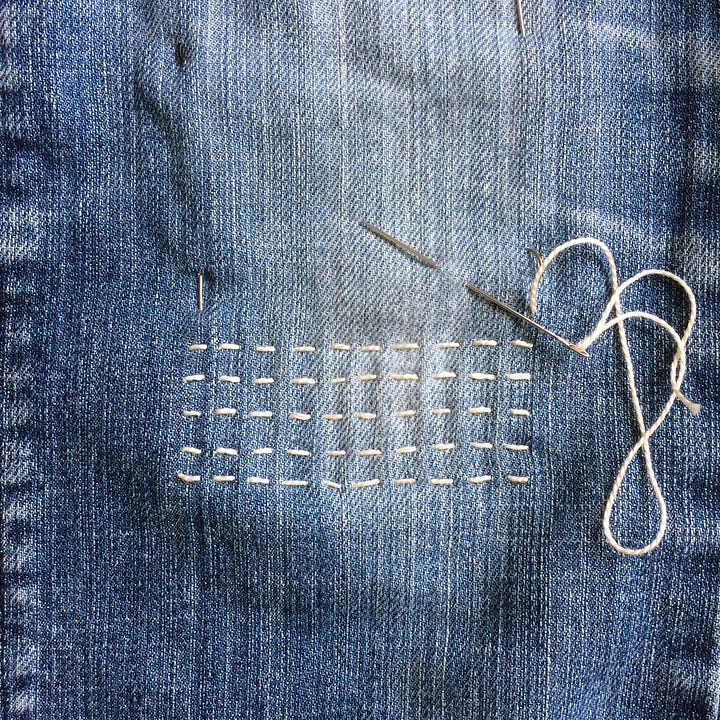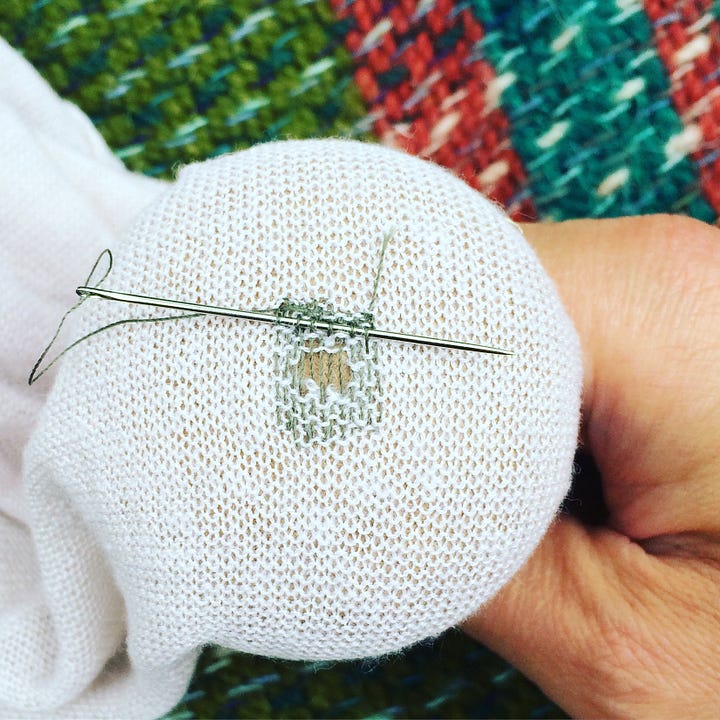

Growing up I learned how to sew. Nothing overly impressive but there was a culture of stitching in my family. Early on I picked up some basics from my Mum and did occasional floral embroidery with my grandmother (along with a few other niche skills she imparted like crafting decorative marzipan fruit, polishing the ‘silver’ and setting my hair in finger curls).
I was also lucky to have studied textiles at school, where I got to grips with a sewing machine, breaking numerous needles along the way. Pouring over copies of Vogue in my teens was legitimately schoolwork, contributing as it did towards my fashion modules. I always struggled with subjects when I didn’t understand their real-world application and Textiles, with its focus on fibre composition, fabric construction and fashion history was totally my bag. Okay, it may not be particle physics, but I wonder how many scientists can decode the symbols on a garment’s laundry label like I can.
Considering I learned the value of sewing in my childhood, perhaps it’s a surprise that by my late teens I was a fast-fashion addict - shopping had turned into a serious hobby. Despite my knowledge of modern couture, 18th century fashion and the birth of ready-to-wear, it hadn’t occurred to me to question the provenance of what I put in my wardrobe.

Around the same time that my love of vintage took hold in my mid-20s (thanks to eBay and the charity shops of South London), my understanding of the fashion system expanded. At that time, I was an actor living in London-town and aside from working at least three jobs to pay the bills between acting gigs, I was pretty care-free. However, watching the TV show ‘Blood, Sweat and T-shirts’, and seeing a play that featured poor working conditions in a footwear factory opened my eyes to the realities of the garment industry. Until that point, I’d been blissfully unaware, looking at the fashion mags and my wardrobe through cheap, mass-produced, rose-tinted specs.
From that point on I made a pact not only to change my own buying behaviour but to find a way to shift the public’s perspective and show there is another way to dress. After training and working as a personal stylist with a focus on ethical fashion, I soon realised that my impact was limited to my individual clients. At that time the ethical stylist concept was new so it wasn’t an easy sell. More importantly, except for the writing I was doing for independent publications, what I was offering was inaccessible to most people. So, to reach a wider audience I developed and launched The Good Wardrobe, an online sustainable fashion hub which I ran for around ten years. I’m proud to have created a pioneering platform that supported thousands of people to take a more mindful approach to fashion.
Over the years, the landscape of the industry has changed and so have I. No longer an actor / stylist / writer hanging out at London Fashion Week creating content about the latest sustainable brands - my world has simplified, and my priorities have shifted. Nine years ago this week I moved to Bristol and now have two young kids. Life is simultaneously calmer and more intense. Now, although I still find myself drawn to supporting people to make more mindful, sustainable choices, the way I want to do this has changed.
One of the sewing skills I’ve learnt as an adult is mending, specifically visible repair and darning. I wear my work like a badge of honour, a proud protest against the broken fashion system. As a parent who works from home around school hours, a lot of my life is woven around my kids. I wouldn’t have it any other way, yet my identity sometimes takes a hit. Mending my clothes gives me that power back, enables me to express myself and feel a sense of achievement that doesn’t always (but perhaps should?) come from parenting two amazing, hilarious, determined, creative kids.
My mends also serve as inspiration to other parents at school pick up and to people I meet through work, many of whom want to have a go at mending themselves. At the very least seeing clothes that have been unapologetically, visibly repaired makes people start to think differently about the opportunities to care for and repair their own clothes. It also acts as fantastic marketing for my visible mending commissions.
And so, each week I’ll be sharing mends, kits, tips and stories which I hope will offer inspiration for how our well-loved clothes can not only be saved but made even better than new. I may signpost other menders, makers and resources including good news in fashion and beyond. Make sure you don’t miss a post by signing up below.
Here’s what’s up for the week ahead…
My mending pile: a million pairs of my sons’ joggers, all with holey knees (the bane of my life!)
What I’m reading: Small Pleasures by Claire Chambers. The reviews of this novel set in the mid 20th century enticed me but as it turns out, one of the main characters is a dressmaker so the descriptions of bespoke 1950s frocks are a bonus
Next week on The Mending Kit: discover how I patch up my woollen Seasalt gloves that are threadbare at the fingers and thumbs after years of service




